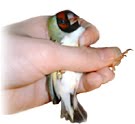Finches love to have visual contact with people, however, typically do not like to be handled. Talking and whistling to your bird will provide them the interaction and socialization they need. The soothing sounds of the male bird make the finch an
entertaining pet.
There are several methods of catching a finch. You can purchase a finch net, which comes in different sizes, but always has very fine mesh attached to a circular wooden or plastic frame with a fairly long handle. These are most convenient for larger flight cages and aviaries where birds have more space to get away from you. The best method of catching them is by letting them land on a wall or floor of the cage and then quickly but carefully maneuvering the opening of the net completely over them and then tapping the side of the cage (if possible) to scare them further into the net. Quickly retrieve the net with bird in it and turn it so that the net droops over the side of the opening (thus closing it off) and the bird is trapped inside. Once the net is out of the cage carefully wrap your hand around the netting just below the opening of the net so that the finch cannot escape and fly away.
The second method of catching a finch is simply by hand. This method is best in smaller cages where you can reach all corners and walls with just your arm's length, and is especially useful if you can remove all perches from the cage prior to attempting to catch the bird.
 Gently but quickly pin the bird to the side or floor of the cage. Be sure that your hand is completely around the body of the finch, securing its wings so that it cannot wiggle out and escape, before you remove your hand with the finch in it from the cage.
Gently but quickly pin the bird to the side or floor of the cage. Be sure that your hand is completely around the body of the finch, securing its wings so that it cannot wiggle out and escape, before you remove your hand with the finch in it from the cage.One additional technique of catching escapees (in a smaller room where you are familiar with all of the "hiding places" or for catching finches inside of cages) is to dim the lights to where you can just barely see where everything is located. Cover a sunny window and lower the lights so that you can see but the finches cannot. That way they will not be able to fly around as much and you should be able to catch them with more ease.
Holding a finch Once you have caught the finch, you need to secure it in your hand. One way to hold a finch is by making a somewhat firm but not-too-tight "fist" around the bird's body with your thumb and index finger secured around the bird's neck to where it cannot wriggle out of your grip. Another option is to place the bird's head between your second and third fingers and letting the body rest in the palm of your hand. Be very gentle, however, because you do not want to squeeze too hard or place too much pressure on the sternum (chest) or abdomen, since otherwise the bird may not be able to breathe (asphyxiate). Make sure that the rest of your hand covers the wings of the bird so that it cannot fly away. Use your free hand to perform medicating or toenail clipping, etc. Never hold sick finches up-side-down, as doing so may compromise their ability to breathe.
Holding a finch Note: when clipping toenails, make sure to secure the bird in hand as described above,
 but also to secure the legs between your middle and ring finger (or whatever you are most comfortable with) so that the finch cannot move around too much while you are clipping and cause you to accidentally clip off its toe. There are, of course, other ways to hold the finch with your hand that work equally well, but make sure that the bird is secure before you proceed with any clipping. For beak trimming, of course, you will need to secure the head (very important!) with your thumb and index finger in a way that you do not apply too much pressure nor block the nostrils. To accomplish this, gently but firmly place your fingers on either side of the mandibles
but also to secure the legs between your middle and ring finger (or whatever you are most comfortable with) so that the finch cannot move around too much while you are clipping and cause you to accidentally clip off its toe. There are, of course, other ways to hold the finch with your hand that work equally well, but make sure that the bird is secure before you proceed with any clipping. For beak trimming, of course, you will need to secure the head (very important!) with your thumb and index finger in a way that you do not apply too much pressure nor block the nostrils. To accomplish this, gently but firmly place your fingers on either side of the mandibles


Post a Comment